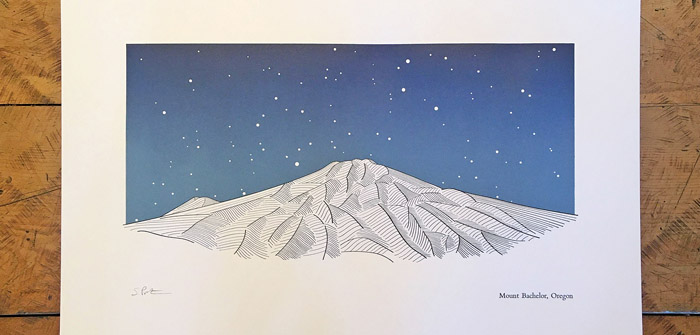(Mt. Bachelor Letterpress Print | Photo courtesy of Susan Porteous)
Susan Porteous is the creative spark behind Green Bird Press, a small letterpress printing and bindery located in the Workhouse in Bend. As a designer of various forms of stationery, she describes her creations as “modern, minimalist and often geeky.” Whether entirely handmade or created using hand-operated machines, Susan’s high quality products resonate with a uniqueness that stems from the slight variations present in them. Because letterpress printing and book binding are both ancient crafts, Porteous seemed the perfect person to chime in on the “art or craft” discussion.
ME: Describe your art / craft.
SUSAN: I own and operate Green Bird Press, a small letterpress printing and book binding operation with a modern, minimalist approach to design. I make prints and cards, bookmarks, journals and other goods, which I sell online and in boutique stores nationwide. Since letterpress is my main thing, let me focus on that and describe a little bit about what that means.
Letterpress is a form of printmaking that was developed in the 15th century in conjunction with moveable type as a means for printing books and other text based media. It remained the primary printing process until offset lithography became popular in the 1950s, closely followed by the invention of digital printing processes at the end of the 20th century. With the adoption of these newer technologies by commercial printers, letterpress equipment was abandoned and slowly passed into the hands of artists and artisans.
There are various types of presses, but the basic idea is that ink is applied to the raised area of a printing plate or type, and paper is pressed onto this inked surface to transfer the image or text. In addition to the transfer of ink, the pressure applied by the press creates a physical impression in the surface of the paper. This visual and tactile quality of letterpress makes it unique from other forms of printing and is one of the reasons I’m drawn to it as a process. I use a combination of traditional metal, hand-set type and printing plates created from digital files for my work.
ME: Do you consider your work art or craft?
SUSAN: Letterpress work is usually considered as a craft as it actively involves a learnt skill and the creation of tangible, often functional, objects made by hand. I also create multiples that can be reproduced an infinite number of times, and my designs are the result of hours of researching and planning, drawing and redrawing, which fits the usual definition of craft much better than it does art. Therefore, my work is mostly craft.
Yet, while craft is practical, art is described as being imaginative and thought provoking. It is art that is said to evoke emotion and feeling and to provide connections. I like to think that my work is not purely practical, and I’ve certainly had many conversations with the people passing through the Workhouse (one of the reasons I love having my studio there) that have started because one of my prints evokes a memory or emotion for them. So, maybe my work can also be art.
ME: As one who has seen your creations firsthand, I can attest to their artistic merits, sometimes evocative, othertimes charming, but always handsomely made!
How does your work address artistic concerns, like those that a painter or sculptor must consider (form, composition, color, value, texture)?
SUSAN: I work in a minimalist style with lots of white space, clean lines and small details. I like working in series and often create rules for myself that inform the composition, drawing style or other elements of the design. I also enjoy breaking these rules when I feel they no longer fit what I’m trying to convey.
The printing process also plays a part in many of my design considerations. For example, each colour in a print requires separate printing plates and an additional run through the press, so I tend to work with a limited colour palette. Sometimes, however, that little spot of colour is exactly what a print needs and is well worth the extra time and effort to incorporate it in the product design.
Earlier, I mentioned the physical impression you get from letterpress that is so evocative. One of my favorite things to do (which I don’t utilize nearly enough) is called blind printing — printing without ink to create just an impression in the paper. Because there is no colour it is visible only by the play of light and shadow or through touch, which is pretty wonderful.
ME: I find the elements you just described quite fascinating! Your mimalist approach leaves much space, both literally and figuratively, for the eye to wander and the mind to imagine. And this idea of texture playing a role without the use of color and instead relying solely on the interplay of light and shadow is very intriguing. I think it demands a certain sensitivity on behalf of the viewer who can appreciate nuance and subtlety.
What is your opinion on the arts / crafts dyad?
SUSAN: I think it’s an interesting subject to debate as there are clear differences and similarities between the two, yet they are not easy to define. I am happy to be called an artist, an artisan or a craftsperson, and would add maker, designer and printer (among others) to the list. Ultimately, I’m lucky that I get to make my living doing something creative that makes me happy, and I enjoy sharing that work with others.
ME: We are all fortunate that you get to do what you love because the joy you experience in making your work is palpable and provides us with joy as well! Thank you, Susan.
To view the exquisite work of Susan Porteous, please visit the Workhouse, located at 50 SE Scott St., #6 in Bend and open daily from 9am-5pm. You may also visit Susan’s website at greenbirdpress.com.

